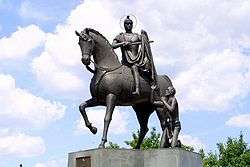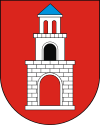Odolanów
Odolanów [ɔdɔˈlanuf] (German: Adelnau) is a town in the Greater Poland Voivodeship of Poland, about 10 kilometres (6 miles) south-west from Ostrów Wielkopolski, with over 5000 inhabitants.
Odolanów | |
|---|---|
 Statue of Saint Martin | |
 Flag  Coat of arms | |
 Odolanów | |
| Coordinates: 51°34′N 17°40′E | |
| Country | |
| Voivodeship | Greater Poland |
| County | Ostrów Wielkopolski |
| Gmina | Odolanów |
| Area | |
| • Total | 4.76 km2 (1.84 sq mi) |
| Population (2006) | |
| • Total | 4,960 |
| • Density | 1,000/km2 (2,700/sq mi) |
| Postal code | 63-430 |
| Climate | Cfb |
| Website | http://www.odolanow.pl |
History
The first written document that mentions Odolanów dates back to 1301 under the Piast dynasty, when the location hosted a castle on the border between Greater Poland (Wielkopolska) and Silesia (Śląsk). A settlement arose next to the castle, which acquired city rights in 1403 from King Władysław II Jagiełło.
In 1629 on the east side of the town king Sigismund III Vasa founded the New Town also called Konstancja (after the king's second wife). Nowadays it is a part of Odolanów named Górka. At the end of the 17th century there were 18 shoemakers, 8 tailors, 3 millers, 3 tradesmen and 9 other craftsmen in the town. The majority of the population were tilthing and breeding cattle.[1]
Until 1793, the town and surrounding villages belonged to princes, kings, or noblemen. Monarchs granted land to various rich feudals as fief or land tenancy. During this time, Odolanów was under the administrative influence of Kalisz.
In 1793 Odolanów became Prussian as a result of the second partition of Poland, and shortly within the Duchy of Warsaw.
The citizens took part in the Spring of Nations, fighting against better armed Prussians in the battle of Odolanów on 21 April 1848. They also supported the Polish January Uprising of 1863, delivering weapons and clothes to the insurgents.[2]
Despite the germanisation led by the German Empire, Odolanów preserved its Polish character – in 1910 at least 72.5% of inhabitants were speaking Polish. In addition to Poles, Jews and Germans also lived there. The Protestant church built in 1780 and the 1835 synagogue are monuments of Odolanów’s once multicultural society.[3]
In 1909 the rail connection between Odolanów and Ostrów Wielkopolski was opened.[4]
The events shortly after World War I (Republic of Ostrów and the Greater Poland Uprising) are an important part of the town’s history. On 12 November 1918, as a result of the November Revolution in Germany, a Worker’s and Soldier’s Council was established in the town. Some days later the citizens elected deputies to the Polish Parliament in the Prussian Partition (Polski Sejm Dzielnicowy). On 31 December 1918 Poles took power in Odolanów from Germans as part of the Greater Poland Uprising. Insurgents from Odolanów fought a. o. in the battle of Granowiec during the night of 14/15 January 1918.[5] In 1919 the town became part of the Second Polish Republic.
On 1 September 1939 Odolanów was quickly captured by the Wehrmacht. The German administration was using terror, many Poles were expropriated, killed or sent to concentration camps. The German occupation in Odolanów was over on 22 January 1945, when Soviet tanks entered the town. Some soldiers of the Polish underground continued their resistance, now against the Soviet dominance and the puppet Stalinist government (so-called cursed soldiers). On 22 October 1945 the troop of Jan Kempiński, nom de guerre Błysk, operating in the Odolanów area was smashed by the Department of Security forces.[6]
People
- Jan Zborowski (1538–1603), Polish Court Hetman of the Crown
- Rafał Leszczyński (1650-1703), nobleman
- Wilhelm Altmann (1862-1951), historian and musicologist
References
- Franciszek Olszanowski Parafia Świętego Marcina w Odolanowie, Odolanów 1994
- Franciszek Olszanowski Parafia Świętego Marcina w Odolanowie, Odolanów 1994
- Józef Duczmal Kronika Odolanowa, Odolanów 2003.
- Józef Duczmal Kronika Odolanowa, Odolanów 2003
- Józef Duczmal Kronika Odolanowa, Odolanów 2003
- Dawny Powiat Odolanowski na starych pocztówkach 1887-1932, Raszków, 2012, red. Jacek Bartczak.
External links
- Odolanów On-Line (in Polish)